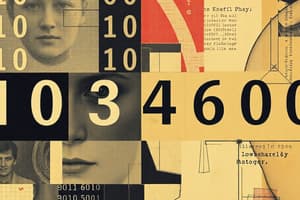Podcast
Questions and Answers
What is the primary reason why computers use binary instead of decimal number system?
What is the primary reason why computers use binary instead of decimal number system?
- Because binary is more widely used in human society
- Because binary is more efficient for processing large files
- Because binary is more easily understood by humans
- Because binary requires only two states, making it easier to process and taking up less space (correct)
What is a bit in the context of computers?
What is a bit in the context of computers?
- A combination of 10 digits
- A single number, either 1 or 0 (correct)
- A unit of measurement for file size
- A group of 10 ones and zeros
What is the advantage of using binary in computers over decimal?
What is the advantage of using binary in computers over decimal?
- It reduces the amount of space required to store data (correct)
- It increases the processing speed of computers
- It allows for more complex calculations
- It makes computers more accessible to humans
What is the analogy used to describe how binary works?
What is the analogy used to describe how binary works?
What is the reason why computers do not use decimal number system?
What is the reason why computers do not use decimal number system?
What is the relationship between the size of a file and the number of bits it contains?
What is the relationship between the size of a file and the number of bits it contains?
How do computers process binary information?
How do computers process binary information?
Flashcards are hidden until you start studying
Study Notes
Decimal Number System vs. Binary System
- Throughout history, almost every civilization has used a decimal number system with 10 digits (0-9) to represent all possible numbers.
- Computers, however, operate using a binary number system with only 2 digits (1 & 0).
Binary System in Computers
- Binary is a number system with two digits (1 & 0) that computers use to process digital information or data.
- A bit (short for binary digit) is a single number, either 1 or 0, that can be combined to create larger units like bytes, megabytes, and so on.
- The larger a file is, the more bits it has; for example, a high-resolution video is made up of millions of ones and zeros.
How Binary Works
- Binary can be thought of as a light switch, where 1 represents "on" and 0 represents "off" with no other possible states.
- Bits are strung together in different combinations of ones and zeros to form a code that the computer rapidly processes and translates into data.
Why Computers Use Binary
- Computers use binary because it has only two states (on and off), making it easier to process and taking up less space.
- If computers used decimal, they would have to process 10 states, making it more complex and difficult.
Decimal Number System vs. Binary System
- Humans use the decimal number system, which consists of 10 digits (0-9), to represent all possible numbers.
- Computers, on the other hand, operate using the binary number system, which consists of only 2 digits (1 & 0).
Binary System in Computers
- Binary is a number system with only two digits (1 & 0) used to process digital information in computers.
- A bit (binary digit) is a single number, either 1 or 0, that can be combined to create larger units like bytes, megabytes, and so on.
- The size of a file depends on the number of bits it contains; for example, a high-resolution video consists of millions of ones and zeros.
How Binary Works
- Binary can be thought of as a simple on/off switch, where 1 represents "on" and 0 represents "off".
- Bits are combined in different sequences of ones and zeros to form a code that computers rapidly process and translate into data.
Why Computers Use Binary
- Computers use binary because it has only two states (on and off), making it easier to process and more space-efficient.
- If computers used decimal, they would have to process 10 states, making it more complex and difficult.
Studying That Suits You
Use AI to generate personalized quizzes and flashcards to suit your learning preferences.




